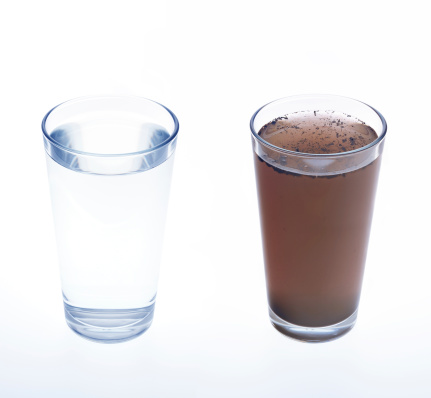Fancy some diclofenac in your water? No? How about some nice 17-beta-oestradiol instead? If you live in the European Union (EU), you may well be drinking these and other substances already – and nothing much is being done about it. And if you’re not already familiar with these drugs, you might like to know that diclofenac is a popular non-steroidal anti-inflammatory drug (NSAID) and that the oestradiol in our drinking water originates mainly from contraceptive pills and hormone replacement therapy (HRT).

Polluting the medium of life
Water is a remarkable substance, with a huge list of unusual properties that make it uniquely suited to supporting and maintaining life. What other substance can do this, for example? Population-wide provision of clean, inexpensive tap water is one of the most notable achievements of industrialised society, largely responsible – along with wastewater management – for the huge improvements in public health observed over the past century or so.
Ironic, then, that pharmaceutical medicine – which, its adherents tell us, is right up there with clean water as a reason for improved public health – is responsible for polluting our water supply, potentially undoing all that good work.
Recognising the problem
Dr Emma Rosi-Marshall of the Cary Institute of Ecosystem Studies has been studying the problem of pharmaceutical pollution of streams in the US. A paper soon to be published in the journal Ecological Applications reports the results of her studies of streams in New York, Maryland and Indiana. “Pharmaceutical pollution is now detected in waters throughout the world,” says Dr Rosi-Marshall. “Causes include aging infrastructure, sewage overflows, and agricultural runoff. Even when waste water makes it to sewage treatment facilities, they aren't equipped to remove pharmaceuticals. As a result, our streams and rivers are exposed to a cocktail of synthetic compounds, from stimulants and antibiotics to analgesics and antihistamines.” At present, the US Environmental Protection Agency appears to be somewhat behind the curve.
The problem is recognised in the EU through three pieces of legislation: the Water Framework Directive (WFD; 2000/60/EC), REACH (Regulation (EC) 1907/2006) – which stands for Registration, Evaluation, Authorisation and Restriction of Chemical substances – and the Directive on Environmental Quality Standards (2008/105/EC). Signed into law in 2000, the WFD established a list of ‘priority substances’. The Directive aims for the, “Progressive reduction of discharges, emissions and losses of priority substances,” and for the, “Cessation or phasing-out of discharges, emissions and losses of the [subgroup of] priority hazardous substances [identified among the priority substances]”. However, none of the priority substances are pharmaceuticals, and was not until November 2012 that the Committee for the Environment, Public Health and Food Safety (ENVI) voted to adopt a proposal to add three drugs to the list: diclofenac, 17-beta-oestradiol (EE) and 17-alpha-ethinylestradiol (EE2). The former is an anti-inflammatory commonly prescribed for arthritis, while the latter two are synthetic oestrogens used as oral contraceptives.
Legislatory logjam
Last week, the European Council – consisting of representatives of the EU’s 27 Member States – rejected the proposed deal, sending it back to the negotiating table. Most Member States did not want the three drugs added to the priority substances list at all, and there was disagreement over when the measures should be implemented. The result confirmed a prediction made by Nature magazine that the measure would be “Dead on arrival,” in the European Parliament – albeit a little later than Nature anticipated. Nature also noted the environmental effects of the three named pharmaceuticals: endocrine-disrupting effects in the case of the oestrogens, and disruption of cellular function in the liver, kidney and gills fish in the case of diclofenac.
The usual suspects
According to Axel Singhofen, European Parliamentary advisor to the Green group, “There was no proper discussion about the environmental impacts of these chemicals in the committee; it just boils down to politics”.
For the moment, at least, pharmaceutical companies are free to continue poisoning the well of life.
Avoiding chemicals in municipal drinking water
Presently there are four main ways of avoiding these chemicals in our tap water. These are:
- Use certified spring or well water
- Buy bottled spring water, preferably in glass rather than plastic bottles to avoid oestrogen mimics, such as bisphenol A in plasticisers
- Use a reverse osmosis filtration water system, preferably replacing minerals removed with additional trace and ultra-trace elements that are required for good health and proper hydration
- Use water distillation to deliver water free of added chemicals. Again, re-mineralisation of distilled water is preferable.
For more information:
ANH Clean Drinking Water campaign page
ANH Europe homepage








Comments
your voice counts
04 April 2013 at 12:12 am
I agree that RO and distilled water is the safest and purest water you can drink, but I don't think it's necessary to 'remineralise' it, especially not with inorganic minerals, which the body's cells will reject. We get 95% of the organic minerals we need from a healthy diet. As soon as you drink distilled water, it mixes with the remains of your last meal in your stomach, so can then be considered remineralised. The main thing is to make sure your water is truly clean and safe to drink.
26 March 2014 at 2:13 am
Distilled water is great but it has no minerals, therefore RO water and SIBROM filtration is the way to go. Not everyone has healthy diet, so i think minerals are still important in he water.
Your voice counts
We welcome your comments and are very interested in your point of view, but we ask that you keep them relevant to the article, that they be civil and without commercial links. All comments are moderated prior to being published. We reserve the right to edit or not publish comments that we consider abusive or offensive.
There is extra content here from a third party provider. You will be unable to see this content unless you agree to allow Content Cookies. Cookie Preferences